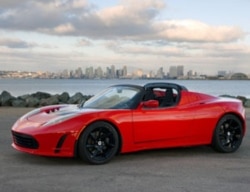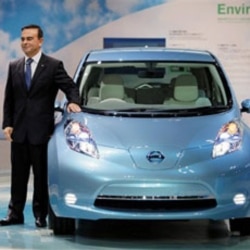Or download MP3 (Right-click or option-click and save link)
SHIRLEY GRIFFITH: I’m Shirley Griffith.
STEVE EMBER: And I’m Steve Ember with EXPLORATIONS in VOA Special English. Starting this Friday, the auto industry will show off more than nine hundred of its latest vehicles at the LA Auto Show in Los Angeles, California. The event provides a look at about fifty hybrid, electric and alternative fuel cars that could soon be available in the United States.
Join us as we discuss the new kinds of cars, and what this means for the future of driving in America.
(MUSIC)
SHIRLEY GRIFFITH: At the beginning of the nineteen hundreds, the automobile was rare. Many early models ran on electric batteries. It was not until Henry Ford’s gas-powered Model T that the internal combustion engine and the car became inseparable.
Henry Ford had wanted to develop an electric car. But the technology of the time was not ready. Today, the same problems faced by early automobile pioneers remain. But materials are available to overcome the old problems. The result is that electric batteries and motors may finally power cars of the future. Some experts predict that five to ten percent of cars on the road in twenty twenty will be electric.
STEVE EMBER: The heart of any electric car is its battery. A battery stores electricity and makes it available for use by the motor. Partly electric cars are already common in many countries, including the United States and Japan.
Hybrid vehicles run on both electric power and gasoline. The Toyota Prius is the top selling hybrid car in the American market today. Most current hybrid cars use an internal combustion engine to drive the car and to help provide electric power that is stored in a battery. The battery then uses its stored energy to run the car at low speeds.
SHIRLEY GRIFFITH: The race to develop electric cars and other fuel-efficient models took on greater urgency earlier this year. The Obama administration set new rules in the United States. They require two thousand sixteen model vehicles to get an average of fifteen kilometers to a liter of gasoline.
One way to raise the average fuel economy is to increase the number of electric cars on the road. And manufacturers are rushing to get electric vehicles and hybrids on the market. At this year's LA Auto Show, many models will be on display.
STEVE EMBER: No car in recent years has been as important to a manufacturer as the Chevy Volt is to General Motors. The electric hybrid car is set to be released next year.
GM plans to sell stock to the public soon -- possibly raising as much as seventeen billion dollars. GM has reported over four billion dollars in profit this year. The company suffered huge losses during the economic crisis of two thousand eight and two thousand nine. The Volt could change all that. It could be a sign that GM has recovered from the bankruptcy and restructuring it went through last year.
GM started taking orders for the Volt in July. The General Electric company has promised to buy twenty-five thousand electric vehicles. This includes one thousand Chevy Volts next year and thousands more to come.
SHIRLEY GRIFFITH: The Volt is designed to run as an electric car for more than sixty kilometers. After that, a gasoline engine powers the car. The battery and the gas generator let the Volt travel a total of about five hundred sixty kilometers on one charge and tank of gasoline.
What is different about the Volt is that its electric motor always runs the car. Gasoline is used only to generate electricity. GM engineers say they chose this design because it is ten to fifteen percent more efficient. They also used a new, lithium-ion battery that is expected to last longer than batteries in current hybrid cars.
GM is selling the Volt for about forty-one thousand dollars. This is more than two times the cost of other small GM cars. But buyers can get a seven thousand five hundred dollar tax credit from the government for buying a Volt.
In the past, fuel-efficient cars have been small cars that Americans have rejected -- at least when gasoline prices are low. High school and college students are a big market for such vehicles. But a change has taken place in the world of environmentally friendly cars. Several are sports cars.
(SOUND)
STEVE EMBER: Tesla is a new carmaker based in Palo Alto, California. The company's chief executive is Elon Musk. He is also known for leading SpaceX, a space travel company. Tesla's goal is to make more affordable all-electric cars. The Tesla Roadster, however, has attracted a lot of attention for being a fast sports car that costs over one hundred thousand dollars.
Tesla cars were first offered for sale in two thousand eight. The company says there are now one thousand three hundred Roadsters being driven around the world.
The Roadster can reach speeds up to about two hundred kilometers an hour. And it releases zero pollution. It can travel almost four hundred kilometers before it needs recharging, depending on how fast it is driven.
Fisker Automotive is a new carmaker based in Irvine, California. Its costly sports car is called the Karma. Like the Chevy Volt, the Karma runs on electricity at first. Then it uses gas to power an electric motor. It also has solar panels on the roof. The company says the panels collect enough energy to extend the life of the battery charge. Fisker says the Karma travels about twenty-nine kilometers on a liter of gas and a full electric charge.
(MUSIC)
SHIRLEY GRIFFITH: Not all new, fuel-efficient cars are electric or hybrid. Diesel engines have long been used in trucks and buses that travel long distances. Diesel fuel is more dense than gasoline. It produces more energy when it burns. High levels of sulfur in diesel made from petroleum have meant diesel engines produce a strong smell. Newer, more refined diesel solves this problem.
Don Hillebrand is the director of transportation research at the Energy Department's Argonne National Laboratory near Chicago, Illinois. His team of engineers works on new diesel technology. He says until recently, American car makers have not offered many diesel cars in the United States.
DON HILLEBRAND: "Many of the American-based companies make outstanding diesel engines, but they only sell them overseas. They don't actually sell them in North America."
Don Hillebrand also says diesel can help in lowering the use of carbon-based fuels.
DON HILLEBRAND: "The diesel can give you an extra thirty percent fuel economy, which is a substantial amount of carbon reduction and a substantial amount of cost savings."
The Ford Motor Company makes diesel vehicles for the European market and could sell them in the United States. And GM has said it will manufacture a diesel passenger vehicle for the American market soon.
STEVE EMBER: Yet, gasoline engines remain the most common in passenger vehicles in the United States and are expected to remain so. Some manufacturers are pushing cars to new levels of fuel efficiency.
GM is offering the Chevrolet Cruz Eco. It has a gas-powered engine that is more fuel efficient than most hybrid models. The car travels about seventeen kilometers on a liter of gas.
And then there is extreme fuel efficiency. The Edison2 is an experimental car that was one of the winners of the ten-million-dollar Progressive Insurance Automotive X Prize. The prize was given to teams that could design a vehicle that could travel one hundred miles or more on one gallon of gas. That is at least forty-three kilometers a liter.
Oliver Kuttner led the Edison2 team. He says electric cars have a problem with weight. He says their batteries weigh too much. He believes very light-weight cars are more efficient than electric cars can ever be. The Edison2 car uses E85 fuel that is mostly ethanol, a form of alcohol.
SHIRLEY GRIFFITH: But all-electric cars that the public can afford to buy are no longer something for the distant future. Japanese carmaker Nissan has said it will offer its LEAF for sale next month.
The LEAF has no gas engine. It runs completely on stored electric power. The company has not released exact performance details. But Nissan says the LEAF will run for about one hundred sixty kilometers between charges. The company says ninety-five percent of drivers travel fewer than one hundred sixty kilometers a day.
The Chevy Volt and the Nissan LEAF are among five cars competing for the 2011 Green Car of the Year award. The other finalists are the Ford Fiesta, the Hyundai Sonata Hybrid and the Lincoln MKZ Hybrid. The prize is given by Green Car Magazine which has been writing about cars, energy and the environment for eighteen years. The winner will be announced at the LA Auto show on Friday.
(MUSIC)
STEVE EMBER: This program was written and produced by Mario Ritter. I'm Steve Ember.
SHIRLEY GRIFFITH: And I'm Shirley Griffith. Go to voaspecialenglish.com for pictures and MP3s of our programs. And follow us on Facebook, Twitter, YouTube and iTunes at VOA Learning English. Join us again next week for EXPLORATIONS in VOA Special English.






